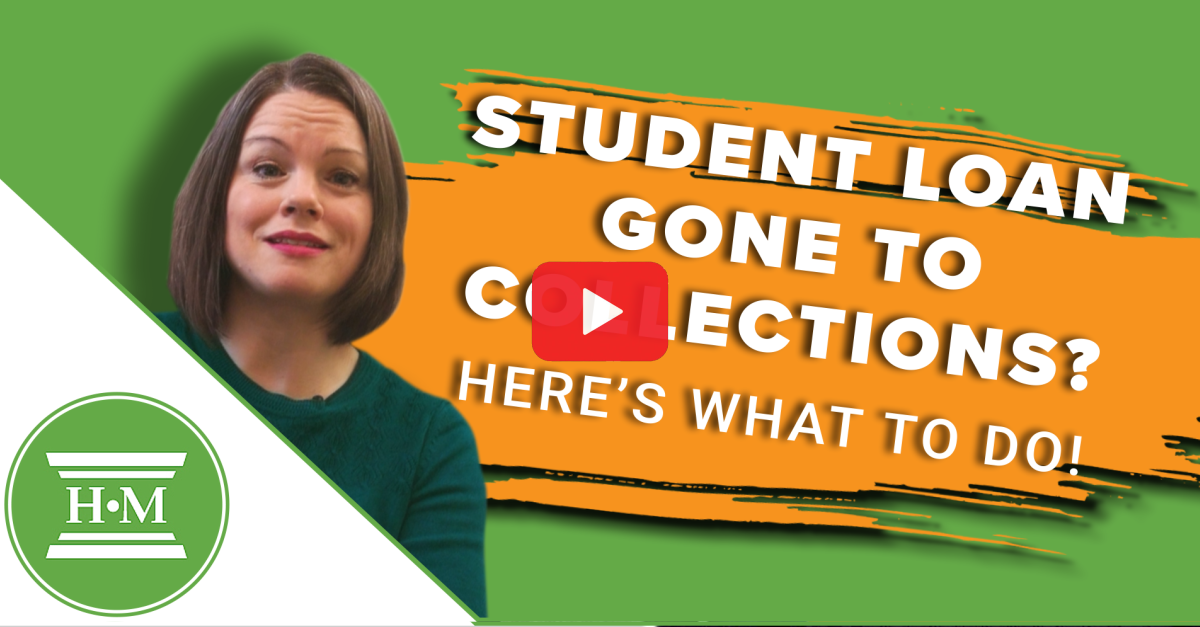
Like any other type of debt, if you fall behind on payments, your student loan creditors can send your account to a collection agency. In this post, I’ll explain who will collect on various types of student debt and what you can do if your student loans are in collection.
Table of Contents
Who collects student loans & when will they go into collection?
What happens when your student loan is in collections?
If you fall behind on your student loan payments, your account can be sent to collections, just like with any other debt.
Hi, I’m Maureen Parent, a Licensed Insolvency Trustee with Hoyes, Michalos & Associates.
There are government student loans and private student loans such as a student line of credit with a bank. So what happens when your student loan is in collections? If we’re talking about a student line of credit with a bank, you might receive calls from a collection agency. They can sue you if the debt is not passed the Statute of Limitations period, which is two years in Ontario. If your loan was cosigned and you default on your student line of credit, your lender will look to the cosigner to make those payments.
However, if we are talking about government student loans the consequences can be more severe. Your government loans are typically divided into two parts: a provincial portion and a federal portion. Your provincial student loan can also be sent to a collection agency, once you are a few months in arrears.
However, your unpaid federal student loans are sent to the Canada Revenue Agency for collection. This happens once you’ve missed payments for nine months. The CRA has very strong collection powers. They can withhold your tax refund, GST refund, or any other federal benefits owing to you. They can freeze your bank account and garnish your wages up to 100% without even going to court. The CRA won’t go away until your student loan debt is paid. There is no limitation period on unpaid federal and provincial student debt.
The only way to stop CRA is to make repayment arrangements or file a bankruptcy or consumer proposal. A bankruptcy or a proposal filed with a licensed insolvency trustee can eliminate Canada student loans as long as you’ve been out of school for seven years. Private loans do not have the seven year waiting period. They are treated like your other unsecured debt.
If your Canada student loans are in collection, the question you need to ask yourself is: can you catch up on nine months of late payments?
You’re not eligible for any federal repayment assistance unless your account is current.
If you can’t, consider talking with a Licensed Insolvency Trustee about your options. For more information, come visit us at Hoyes.com.
In Canada, there are government and private student loans.
- Government loans can be federal, provincial or a combination of both. For example, in Ontario, you can have three types of government loans Canada-Ontario Integrated Student Loans, Canada Student Loans or Ontario Student Loans (OSAP).
- Private student loans are generally issued by banks in the form of student lines of credit or student credit cards.
Canada student loans
Your Canada student loan debt is sent to the Canada Revenue Agency (CRA) for collection when you miss nine months of payments. The CRA has expansive collection powers they can use to collect outstanding student debt, including withholding your tax refund, GST credit and more. I’ll explain more about CRA’s rights to collect later in this article.
OSAP loans
Unpaid OSAP debt is sent to a private collection agency you have missed making the required payments for 270 days. The collection agencies typically used by OSAP are ARO Inc., EOS Canada Inc, Financial Debt Recovery Ltd, or Total Credit Recovery.
Bank loans
If you default on private student loan payments, your bank or lender may use their in-house collection department, or they may send or sell your account to a third-party collection agency. Although six months is a general guideline, there is no set rule for when a private loan is sent to collection.
Your bank or other financial institution has no more rights to collect on a student line of credit than they do any other unsecured loan like a bank loan or overdraft, for example. However, it is common for private student loans to be co-signed. If your parents or anyone co-signed your student line of credit, the bank would look to them to make the payments if you are in arrears.
Monies owing to your university or college
You may also owe tuition, fees, residence charges or other costs directly to your university or college. Your school is an unsecured creditor, much like your bank or credit card company. If you owe money, they can also send your debt to a debt collector. However, universities and colleges can also withhold the issuance of your degree until all tuition, fees and outstanding interest have been paid.
Will my student loan arrears show on my credit report?
In short, yes. Late payments on your student loans will show on your credit report and can affect your credit score.
Canada Student Loans does report late payments on federal student loans to the major credit bureaus. In the case of private student debt, your bank or credit card lender will also report payment arrears to each credit reporting agency.
Late payments lower your credit score and remain on your credit report for six years. Eventually, the account may be marked as ‘in collection,’ which severely harms your credit rating.
Filing a bankruptcy or consumer proposal freezes late payments at the date of filing. However, Canada Student Loans often continues to report late payments during your proceeding. Once you receive your discharge or certificate of completion, you can contact the credit bureaus to erase all of the ‘late payments’ after your original signup date. Fixing this error will help your credit score by ensuring your credit history is accurate and allow these late payments to be purged six years from the date you filed insolvency. Your bankruptcy or proposal would be removed based on those retention periods.
What powers does the government use for student loan collections?
Having your government student loans sent to collection has consequences beyond what an ordinary debt collector can do to collect. This is because the Canada Revenue Agency has more power to collect on a debt than other creditors.
A non-government creditor must take you to court and obtain a judgement before they can garnish your wages or freeze your bank account. A garnishment order by a private lender is restricted to 20% of your wages.
CRA does not need to go to court to freeze your bank account or garnish your wages. They are also able to garnish 100% of your wages. CRA has the authority to take amounts from any government benefits or credits you receive even if you have a payment arrangement with them and are making payments.
CRA will keep your income tax refund to apply towards either your Ontario or federal student loan. It will also typically keep your GST refund.
Additionally, there is no limitation period for federal student loans. While ordinary unsecured creditors must pursue legal action within a specific time limit (2 years in Ontario), CRA can use its collection tools at any time.
The only way to stop CRA collection actions is to file a bankruptcy or consumer proposal.
How to get your student loan out of collection
When it comes to dealing with student loans in collection, there are a few things to consider.
Repayment assistance
The only payment assistance available through the federal government is through the Repayment Assistance Plan (RAP). To be eligible for help under the Canada student loan rehabilitation program, you must be up-to-date on your student loan payments. However, if you have a defaulted loan that is already nine months in arrears and CRA is contacting you for collection, it is unlikely you can afford to bring your monthly payments current.
In that case, your next alternative to stop CRA actions is to talk with a Licensed Insolvency Trustee.
Is your student loan dischargeable?
Filing a bankruptcy or consumer proposal can be the right choice for a fresh start. Once you file, you will be under what is called a “stay of proceedings“. This stay provides you with automatic legal protection from creditor actions, including the actions of the CRA.
To know if your student debt can be discharged in a consumer proposal or bankruptcy, you must confirm your end of study date with both the Canada and provincial student loan departments. The Bankruptcy and Insolvency Act states that any debt under the Canada Student Loans Act or the Canada Student Financial Assistance Act survives a bankruptcy or proposal if it has been less than seven years since your last end of study date. The date you received any loan is not the deciding factor in what happens to your student loans after seven years.
For private student loans, the seven-year rule does not apply. Unsecured loans you took out with a private lender to pay for school can be automatically discharged through a bankruptcy or proposal. However, if these loans were co-signed and you file insolvency, your lender will pursue the co-signer for payment.
If your student loan debt survives your insolvency proceeding, talk with your trustee about the possibility of making payments to student loans during your filing. The stay of proceedings means you do not have to make payments, but it may make sense to at least make interest-only payments. You will need a letter from your trustee authorizing you to make voluntary payments.
Under the Bankruptcy and Insolvency Act, you can apply to the court to have your student loan debt discharged after five years. However, it is up to the judge to decide if it will make such a court order, and you must be able to prove financial hardship. This application is generally made with the help of a lawyer so you will need to consider the cost.
Are you in or planning on returning to school?
If you are currently in school or planning on returning, it is important to understand how defaulting on your student loans will impact your ability to receive new student loans.
Once your government student loans are in collections, you cannot receive further student aid until your loan payments, including outstanding interest, are brought current.
If you file a bankruptcy or consumer proposal to deal with government student loans, you cannot receive a new student loan until three years after your discharge or completion.
If you are in school or expect to return and need additional student loans, talk with both NCSL and your trustee before filing about the full implications of filing insolvency to deal with student loan debt.
Getting help
If you have student loans in collection with CRA, talk with a Licensed Insolvency Trustee about your options. We will look at how long you have been out of school, whether you have other debts that may prevent you from paying back your student loans and provide you with options that can help you move forward from your debt.





